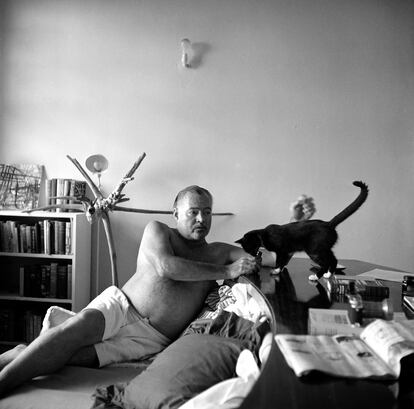Ernest Hemingway ended his life looking for six toes on a cat.


Ernest Hemingway was a man of contradictions, as men of genius are. His passion for hunting stands out from his life experience, as demonstrated in Green Hills of Africa , his book dedicated to hunting; a lengthy report that has just been reissued by Lumen with a translation by Damián Alou.
To justify his determination to take a wild boar, Hemingway argued that "ornamental kills" should be avoided, no gratuitous killing "except when the desire to take the wild boar is greater than the desire not to kill it." In this way, bordering on metaphysics with the help of desire as a literary category , Hemingway justifies his activity; he credits his shots to bringing down large antelopes whose twisted antlers became hunting trophies to be displayed in the salons of the time. We are talking about the mid-1930s, when this book was published, which condenses the entire imagination of one of the best North American authors of the last century; a paradoxical man who transcended the boundaries of literature.
To complete Hemingway's personality, there's his love for the animals that accompanied him: nine dogs, the cow, the great horned owl, and the multitude of cats the writer adopted, especially if they were polydactyls, that is, cats that, due to a curious genetic mutation, have an extra toe. For those who don't know, cats usually have five toes on their front paws and four on their back paws, but polydactyls have at least six toes on any of their paws; it's rare for a cat to be polydactyl on all its paws.
Polydactyly is a hereditary genetic mutation. For a cat to be born with "mittens" on one of its paws, only a minimal genetic sequence in a specific chromosomal region from either parent is required. In the case of Hemingway's cats, it is known that the first of all was a female cat, a gift from his friend Harold Stanley, a sea captain who appreciated this rarity, since polydactyl cats are the best mouse hunters due to the stability acquired with their anomaly, which improves their balance when catching their prey aboard a ship.
The cat was christened Snowball , and it could well be said that the cats now living in Hemingway's former home in Key West—now a museum—are direct successors of this first cat. Generations of cats with this curious characteristic have occupied the writer's home in the Florida Keys; an image that, converted into a literary figure, leads us to identify the rarity of these felines with Hemingway's vital disparity with the world around him.
Hemingway hunted because he was capable of killing what he loved most, including his own life, as he demonstrated on the morning of July 2, 1961, when, at breakfast, he adjusted the barrel of his shotgun to his mouth and pulled the trigger.
Do you want to add another user to your subscription?
If you continue reading on this device, it will not be possible to read it on the other device.
ArrowIf you want to share your account, upgrade to Premium, so you can add another user. Each user will log in with their own email address, allowing you to personalize your experience with EL PAÍS.
Do you have a business subscription? Click here to purchase more accounts.
If you don't know who's using your account, we recommend changing your password here.
If you decide to continue sharing your account, this message will be displayed indefinitely on your device and the device of the other person using your account, affecting your reading experience. You can view the terms and conditions of the digital subscription here.

Journalist and writer. His notable novels include "Champagne Thirst," "Black Powder," and "Mermaid Flesh."
EL PAÍS






